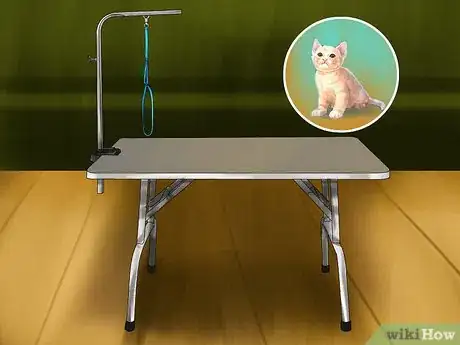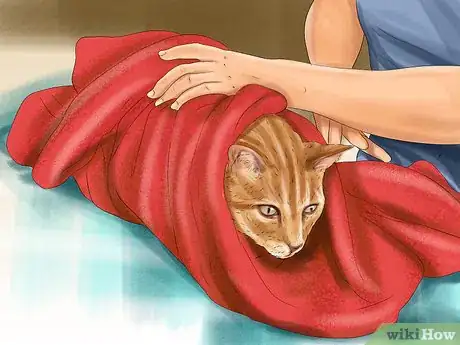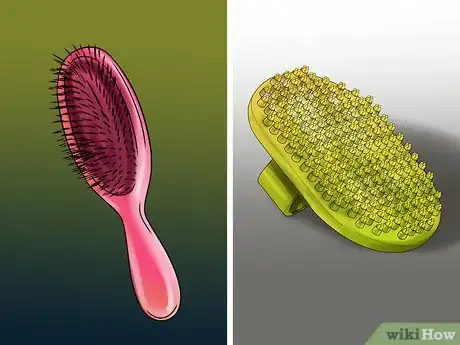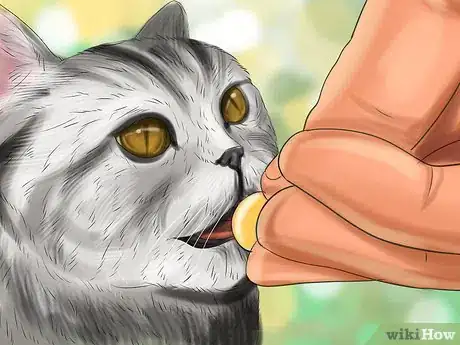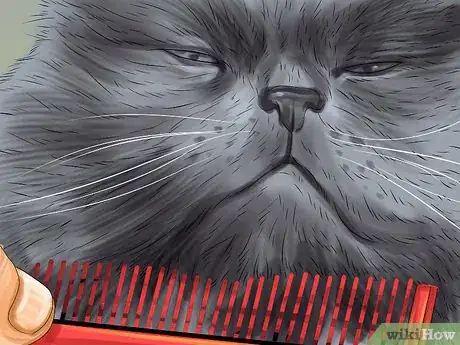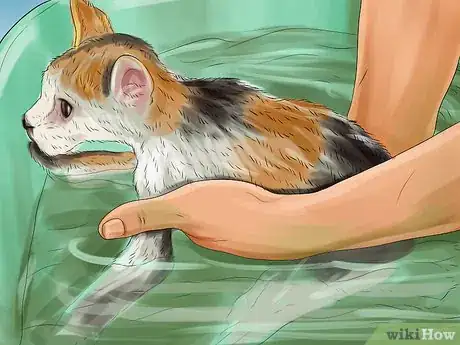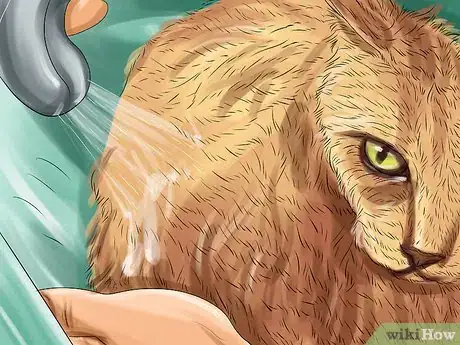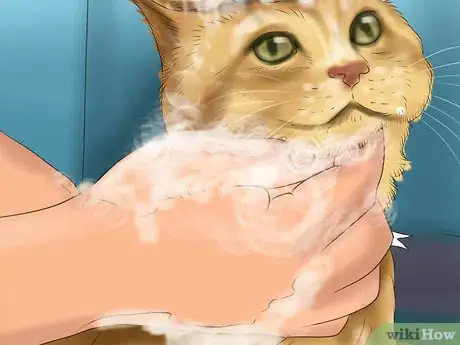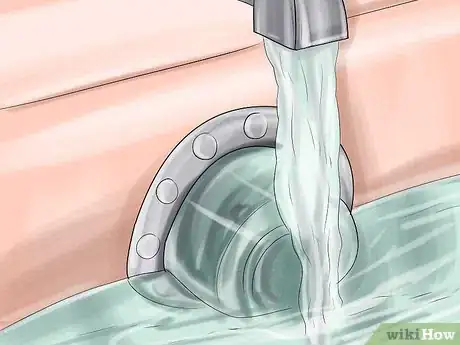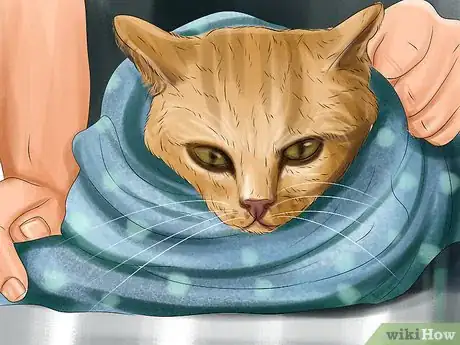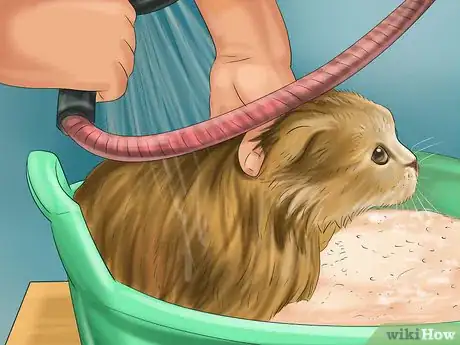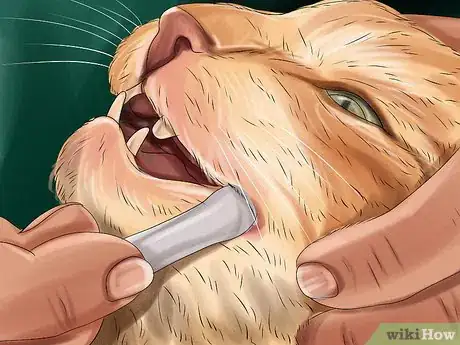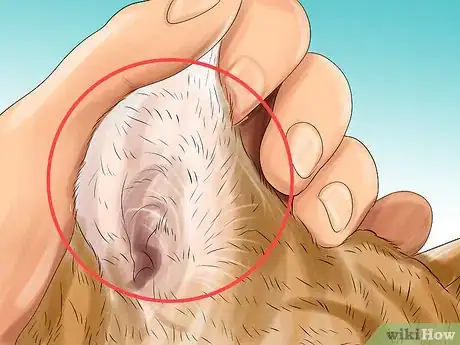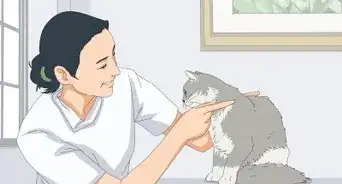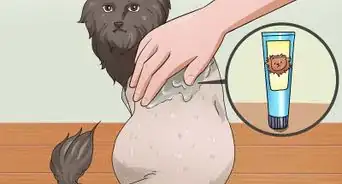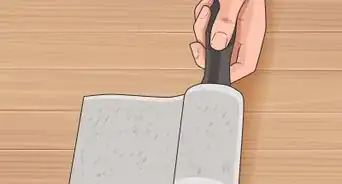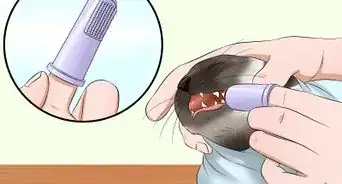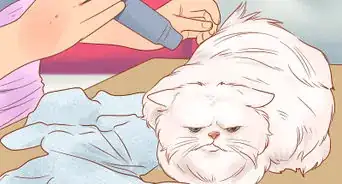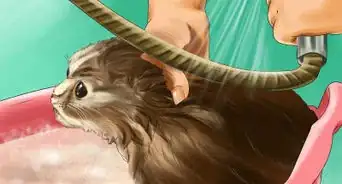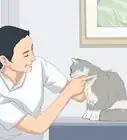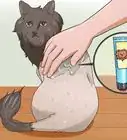This article was co-authored by Lauren Baker, DVM, PhD. Dr. Lauren Baker is a Veterinarian and Assistant Scientist at the University of Wisconsin-Madison. With over 10 years in veterinary medicine, she specializes in the concept of “one health,” which uses insights from veterinary medicine to help human medical research. She holds a Ph.D. in Comparative Biomedical Sciences, a Doctor of Veterinary Medicine, an MS in Comparative Biomedical Sciences, and a Bachelor’s degree in Psychology from the University of Wisconsin-Madison.
This article has been viewed 30,890 times.
As cats get older, they groom themselves less, leading to hair mats, skin irritation, and odor. Senior cats often need assistance with grooming to stay healthy. Maintaining a regular grooming schedule for your senior cat will also it leads a long and happy life. To groom a senior cat, start by keeping the cat calm and relaxed during the grooming session. You can then brush your senior cat, bath it, and groom its nails, teeth, and ears.
Steps
Keeping Your Cat Calm During Grooming
-
1Pick a comfortable spot for the grooming. Senior cats can be anxious or uncomfortable with being groomed. Make your senior cat feel calm by grooming them in a comfortable spot, such as on a soft mat on a high table. You can also place a soft mat on the floor and groom them there. If your senior cat has a favorite spot in your home, consider grooming it there.[1]
- Stick to the same grooming spot every time you groom your cat. This will help your cat get used to the spot and get more comfortable with grooming over time.
-
2Wrap your cat in a towel. If your senior cat tends to fidget or move around when being groomed, use a towel to keep it calm. Wrap your cat in a towel by placing it in the center of the towel and wrapping each side around the cat like a cat burrito. This will keep your cat still and calm during grooming.[2]
- The wrap should be snug, but not so tight that your cat is uncomfortable or distressed.
- You can then move the towel around as you groom your cat. Wrapping your cat in a towel can be a great option when you groom their teeth, ears, or nails as it will help it stay calm and still.
Advertisement -
3Pet your cat a few times before grooming. Calm your cat down by giving them some attention and care before the grooming. Pet your cat from head to toe. Spend time stroking any spots that it likes to soothe it. Say calming words to your cat as you pet it, such as “Good kitty” or “That’s a good kitty.”[3]
- You can also offer your cat a few treats or a can of food if that helps calm and distract them.
Brushing Your Senior Cat
-
1Use the correct brush and comb for your cat. If you have a long-haired cat, use a pin brush. If you have a short-haired cat, use a rubber curry brush. Do not use a brush that has sharp edges or sharp bristles. You do not want to scratch or irritate the delicate skin of your senior cat.[4]
- You should also get a metal comb made for cats. It will have long and short tines to make it easier for you to brush your cat’s undercoat.
-
2Brush your cat from head to tail. Start by brushing your cat with the brush from head to tail. Gently work through its coat. Use the comb once you have brushed your cat once through. Be extra careful when brushing and combing the cat’s hips, hind legs, and underside. It should take you about 15 minutes to brush and comb your cat’s coat.[5]
- Run your hands through your cat’s coat as you brush and comb it. This will help to move the oil in your cat’s coat around.
- Brushing is a great time to check for any lumps or bumps, as well as any areas that seem like they might be causing your cat pain. If you notice any lumps or your cat reacting negatively to touching around their joints and limbs, let your vet know as soon as possible.
-
3Address any mats or tangles. Do not try to cut out mats or tangles, as you risk injuring your senior cat. Instead, hold onto the fur just below the mat and gently brush out the mat with the brush or comb. You can also use your fingers to carefully loosen and remove any mats or tangles. Do not pull or yank on the mats, as this can injure your cat.[6]
- For mats that are hard to get out, try applying a small amount of cornstarch to the mat. Rub the cornstarch in with your fingers and brush it through the mat to remove it. The cornstarch can make it easier for the brush to run through the mat.
- If mats and tangles on your cat’s coat are too hard for you to get out on your own, consider bringing your cat to a professional groomer. The groomer will need to use cat-safe hair clippers to remove the mats.
-
4Reward your cat with treats and praise. Once you have brushed your cat fully, give your cat a treat to end the brushing session. End every brushing session with a treat so your cat feels positive about getting brushed. Don’t forget to also use verbal praise as a reward for your cat, such as “Good kitty” or “Great job.”[7]
-
5Have daily brushing sessions. Long-haired senior cats do well with a good brushing once a day. If you have a short-haired senior cat, you can brush it once a week. Try to brush your cat in the same spot in your home and at the same time, paying extra attention to areas that are prone to matting. Make it part of your care routine for your cat. This way, your senior cat gets less mats and tangles and is not at risk of infection.
- If you notice your cat does not enjoy long brushing sessions, you can try breaking up the session into shorter chunks of time. For example, you may brush your cat five minutes at a time. Give your cat a treat between each mini session so it stays calm and positive.
Bathing Your Senior Cat
-
1Fill the bathtub with warm water. Most cats do not like getting wet and you will need to work fast when bathing your cat. Start by filling your bathtub, or a large plastic bin, with warm water. Only fill the tub or bin with enough water to cover your cat to its belly. Have the water ready before you bring your cat in for the bath.[8]
- Always brush your cat before you bathe it. Get out any knots or mats before the bath, as it will be much harder to get them out while the cat is wet.
-
2Lower your cat into the water. Use reassuring, calming words as you do this. Some cats may not like getting wet and will howl or hiss when you put them in the water. This is normal. Pet your cat and say things like “Good kitty” or “Let’s be calm now” as you lower it into the water.[9]
- If you are worried about water getting into your cat’s ears, you can put cotton balls in their ears.
- If you are bathing your cat in a bathroom or a room with a door, close the door before you put them in the water. That way, it cannot run out of the room while you are trying to bathe it.
-
3Wet your cat’s fur. Dip a clean cloth in the water and gently wet your cat’s fur on her body and chest. Do not pour water on your cat’s head or wet her head right away. You can also use a cup to gently pour water onto your cat’s body and chest. Work slowly and carefully, wetting your cat’s fur.[10]
-
4Lather your cat with cat shampoo. Once your cat is wet, use shampoo made for cats on its coat. Gently rub the shampoo into your cat’s fur. Be careful when lathering around your cat’s ears, eyes, and mouth. Work quickly to lather your cat, as it will likely not be a fan of this part of the bathing session.
-
5Rinse off your cat. You can use a detachable showerhead to do this or a cup. Pour water on your cat gently to rinse off all the shampoo. Rinse your cat several times to make sure there is no leftover shampoo on its coat, as this can irritate its skin.
- If you are using a detachable showerhead, make sure you hold it close to your cat’s body so it does not make too much noise or spray water everywhere.
-
6Wrap your cat in a towel and pat it dry. As soon as you are done rinsing your cat, wrap it tightly in a towel. Pat its coat dry with the towel. Then, keep them in a warm location until they are completely dry.[11]
- Do not use a hair dryer to dry your cat, as this could burn its sensitive skin.
-
7Bathe your cat monthly or as needed. Longhaired breeds should be bathed once a month to keep their coats clean and healthy. Shorthaired breeds should only be bathed if they are very dirty or if they have allergies. Senior cats who are very dirty or have an odor should be bathed as needed to ensure their coats are not prone to infection.[12]
- Your vet can advise you on how often you should be bathing your senior cat, based on its medical history and its breed.
Grooming Your Cat’s Nails, Teeth, and Ears
-
1Trim your cat’s nails once a month. Senior cats are more prone to ingrown toenails and dirty nails. Trim your senior cat’s nails regularly so its nails stay healthy. Use special nail clippers made for cats.
- It may help to wrap your cat in a towel while you trim its nails. Expose only its nails and keep the rest of the cat wrapped up so it remains calm and still.
- If you can, have a second person with you. They can focus on keeping the cat calm and comfortable while you focus on trimming their nails.
-
2Brush your cat’s teeth. Senior cats are also more likely to develop dental issues. Brush your cat’s teeth daily or as often as your cat will tolerate to ensure its teeth stay healthy. Use toothpaste made for cats and a small toothbrush.
- Wrap your cat in a towel if it tends to squirm around while you try to brush its teeth.
-
3Check your cat’s ears. Senior cats can develop ear infections and other issues, especially if they stop self-grooming. Make sure you check your cat’s ears for any sign of infection or injury. If you notice your cat’s ears are red, have an odor, are leaking fluid, or have obstructions in them, bring your cat to the vet.
- Do not stick any objects into your cat’s ears when you examine them. Simply flip over your cat’s ear and check inside the ear canal for any issues.
Things You’ll Need
Brushing Your Senior Cat
- A brush
- A comb
- Cornstarch
- Cat treats
Bathing Your Senior Cat
- Cat shampoo
- Cotton balls
- A towel
Grooming Your Cat’s Nails, Teeth, and Ears
- Nail trimmers
- Toothpaste
- Toothbrush
References
- ↑ http://www.petmd.com/cat/grooming/senior-cat-grooming-tips
- ↑ https://petcentral.chewy.com/senior-cats-need-special-grooming/
- ↑ https://petcentral.chewy.com/senior-cats-need-special-grooming/
- ↑ http://www.hillspet.com/en/us/cat-care/routine-care/how-to-groom-your-cat
- ↑ https://petcentral.chewy.com/senior-cats-need-special-grooming/
- ↑ http://www.hillspet.com/en/us/cat-care/routine-care/how-to-groom-your-cat
- ↑ http://www.hillspet.com/en/us/cat-care/routine-care/how-to-groom-your-cat
- ↑ http://www.hillspet.com/en/us/cat-care/routine-care/how-to-groom-your-cat
- ↑ http://www.hillspet.com/en/us/cat-care/routine-care/how-to-groom-your-cat
About This Article
To groom a senior cat, start by setting up in a comfortable spot and petting your cat soothingly, since seniors can get anxious about grooming. Next, brush your kitty from head to tail, using a pin brush if it's a long-haired cat, or a rubber curry brush if it's a short-haired breed. If you come across any mats or tangles, try to loosen them with your fingers or a sprinkle of cornstarch before working through the knotted fur gently with the brush. Also, be extra careful around the hips, hind legs, and underside! Once you've brushed out its coat thoroughly, give your cat a treat to end the experience on a positive note. For tips from our Veterinary co-author on bathing a senior kitty, read on!
